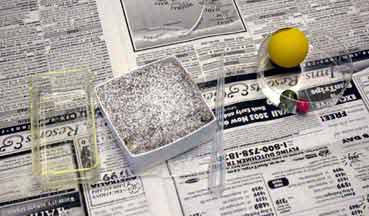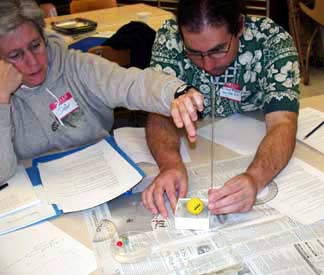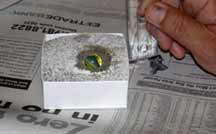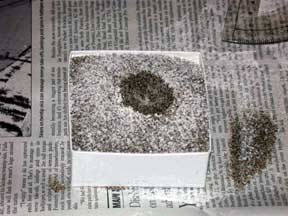return to
Potential to Kinetic
Classroom activity:
What's the Impact?
Purpose:
To investigate the role of kinetic energy (and the factors which influence kinetic energy) in producing landforms and geological structures
Materials:
|
Fine-grained sand |
 |
Procedure:
Part 1
|
Part 2
|
|
 |
2. Smooth the surface of the sand (no need for flour). 3. Drop the ping-pong ball onto the sand from the same height as Part 1. 4. Measure the diameter of the ping-pong ball. Record the diameter, the height of the drop, and any observations from the drop in the table below. |
Part 3
-
Predict what you expect to happen if you drop the red gumball different heights.
-
Smooth the sand and drop the gumball onto the sand from the same height as before.
-
Record the diameter of the gumball, the height of the drop, and any observations from the drop in the table below.
-
Smooth the sand and drop the gumball from twice the original height.
-
Record the height of the drop and compare the observations with what you observed in the first gumball drop.
-
If there is time, drop the gumball at different heights onto the sand, smoothing it before each drop.
-
Continue to record the different heights of the drops and the differences in your observations.
|
Material: |
Diameter (cm): |
Height of Drop (cm): |
Observations: |
|
Marble |
1.4 cm | 15 cm |
It created a circular imprint with a diameter of 1.7 cm and a depth of 0.7 cm. |
|
Ping-pong Ball |
|||
|
Gumball |
|||
|
Gumball |
Questions:
-
When comparing the impacts on the sand, is size OR mass (weight) of the dropped object more important? Which experiment and observations provided evidence for this?
-
When comparing the impacts on the sand, does the height from which the object is dropped matter?
Extension - Exploring Scale:
The physical processes involved in this exercise are the same as those involved with meteor impacts - kinetic energy of falling objects and their effect on the substrate. It is all a matter of scale. To illustrate this:
-
Have students sketch the craters formed by the objects used within this activity.
-
Using a dropper, have students drip one drop of water at a time onto the surface of the sand. Record or sketch the resulting feature.
-
Have students compare these results to photographs of impact craters on Earth, the moon, and Mars
Background Information and Discussion:
Kinetic energy is the energy of an object in motion and is defined
by:
Kinetic energy = ½ (mv2)
m = mass of impacting object
v = velocity of impacting object
In the case of dropped items,
v = 2gh
g = gravity (on Earth this is 980 cm/sec2)
h = height of drop.
Given this information, which should be more significant in controlling the impact: size, mass, or height of drop?
Teacher Comments and Results:
Each of the groups selected their own heights from which to drop the marbles and then repeated the experiment using the ping-pong ball and the gumball. Others continued to work with the marble only, changing the heights, angle, etc.
1. Sample results from a marble drop: see data in table above
Diameter of marble = 1.4 cm
Dropped at 15 cm.
Resulting Crater: It created a circular imprint with a diameter of 1.7
cm and a depth of .7 cm.
2. Findings from group discussion:
|
This crater shows how sediment from the bottom is disturbed during the impact. |
3. Reducing the variables:
How could you design an experiment to test individual factors?
-
Use three different sizes of steel ball; therefore only the amount of mass changes. Weigh each ball. Available at hardware stores.
-
Use only one impactor, but change the heights.
-
Use all the same size objects, but with different densities: wood, steel, marble. Use water displacement to measure the impactor.
-
Get all same size, but different mass: Wood, steel, marble. Use water displacement to measure the impactor.
-
Drop into different substrates.
Teacher Tips:
-
Drop into wet plaster of Paris to create more permanent craters to compare.
-
Use talc or baby powder instead of flour to avoid mildew.
-
To change the angle of the impact, roll the marble down a grooved ruler and measure the angle.
-
Use a paper clip to measure the depth of the crater.
Click here for a text-only, student version of this activity.
Return to: Potential to Kinetic | Dynamic Earth Homepage | UCMP Homepege
 Measure
the diameter of the marble. Record the diameter, the height
of the drop, and any observations from the drop in the table
below.
Measure
the diameter of the marble. Record the diameter, the height
of the drop, and any observations from the drop in the table
below.